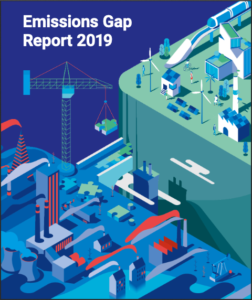What’s the Word from the UN Emissions Gap Report 2019
“Bleak.”
Just in time for the next climate negotiations, to be held in Madrid in December 2019, the UN Environment Programme has published its Emissions Gap Report 2019. The report provides the current assessment of scientific studies on current and estimated future greenhouse gas (GHG) emissions and compares these with the emission levels permissible for the world to progress on a least-cost pathway to achieve the goals of the Paris Agreement. This difference between “where we are likely to be and where we need to be” has become known as the ‘emissions gap’. This is the 10th such report from the UN and over those 10 years carbon dioxide emission have risen 11 percent.
So much for the global commitment to reduce GHG emissions.

Based on this current rate of emissions, we can expect a rise of 3.2 degrees Celsius (5.7 degrees Fahrenheit) of warming by 2100 over the average temperature at the start of the industrial age, when GHG emissions started to change the atmosphere in significant ways.
That 3.2°C rise is more than double the targeted rise of 1.5°C in this time frame. With this increased rise, impacts will be catastrophic, as has been documented by almost every climate breakdown study over the past 30 years. The impacts include extreme weather events, which are becoming all too familiar; the accelerated melting of glaciers; and, the swelling of seas. As a result, the lives of billions of people are and will be at risk.
The Gap report shows how recent developments are aggravating these dire results. For example, some countries, including Canada and Norway, are promoting reduced GHG emissions at home while they expand production of fossil fuels for sale abroad. Other reports have shown that the popularity of sport utility vehicles (S.U.V.s), which burn more gasoline than regular cars, wipes out much of the saving of fossil fuels from the slowly expanding electric vehicle market.
Given the ongoing expansion of GHG emissions, it will now be necessary for emissions to decline by 7.6% every year between 2020 and 2030 in order to make it possible to avoid some of those catastrophic impacts. Yet we see a 1.5% increase every year over past ten years.

While the Report paints a bleak picture, it does offer some hope. It points out that the picture would be even darker if countries had not taken steps to curb their GHG emissions over the past several decades. Renewable energy sources, particularly wind and solar, are rapidly growing. And young people across the globe are actively engaged in public demonstrations about climate breakdown.
It remains hard to be optimistic in light of the decline of international cooperation, thanks to the Trump-Putin alliance and other autocrats across the globe. And let’s not forget that much of the control over those nasty fossil fuels remains with rather self-serving, greedy nation states.
Bleak, indeed.
Sources:
UN Environment Programme, Emissions Gap Report 2019 bit.ly/37JRwVP
Somini Sengupta, “‘Bleak’ U.N. Report on a Planet in Peril Looms Over New Climate Talks,” The New York Times (27 Nov 2019). https://nyti.ms/33rbNfw
Umair Irfan, “UN: The world has backed itself into a treacherous corner on climate change,” Vox (27 Nov 2019). bit.ly/2sgcds6


No comments yet, add your own below